Worms are parasites under the skin that live in the human body. They feed on the host's cells, excreting toxic substances. Parasitic infections can lead to serious illness, and in worst cases, death. Depending on the type of worm, their deviation position is different. Some reproduce in organs, some live under human skin, stimulating the growth of dermatophytes.
Types of parasites under the skin and methods of infection
Parasitic skin diseases are not common diseases. Even so, cases of the disease have been reported. They are most likely after visiting Asian regions and countries with hot climates. Parasites in the human body cause an allergic reaction, accompanied by unpleasant itching.
In medicine, worms are divided into two types:
- Subcutaneous. Helminthiasis is difficult to diagnose. After the infection and adult stage, the parasite moves through the human body. The most common types of worms under the skin are: ironworm, scabies, filariae, rishta.
- Dermatology. After coming into contact with human skin, the parasites migrate to different parts of the body. As a result of skin parasitic infection, pancreatitis occurs, the development of scaly lichen, hemorrhagic disease and diabetes mellitus.
Common cases include localized mite infestation in the sebaceous glands. It is distinguished by an exit to the surface of the epidermis during the day to feed secretions from the dermal ducts.
Heartworm disease
Heartworm disease is the defeat of a person by parasites of the nematode type. It is found in countries in the Asian region, as well as in places with tropical climates. The most likely route of infection is when visiting resorts. The main danger of the parasite is the long incubation period. If there are no symptoms, the worms can live under the skin for 5 to 7 years. Pests are distinguished by excessive vital activity, which causes symptoms of intoxication in patients.
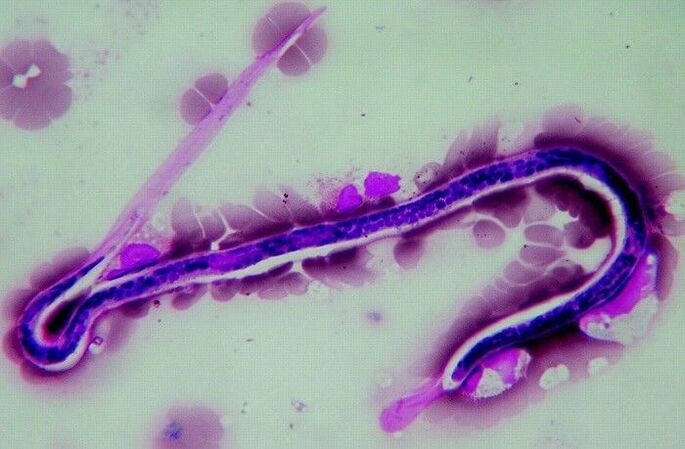
In the early stages, the disease has signs of urticaria. As the worms grow and multiply, the person loses vision, develops movable marks, and becomes feverish. In the later stages, locate the worm with the naked eye.
Dracunculiasis
Heartworm disease is a disease caused by infection with worms under the skin. They can live in open water. Human infection occurs during travel, when drinking raw water from unverified sources. In infected individuals, the larvae reside under the upper layer of the epidermis. The presence of even one parasite without proper treatment can lead to death. In world practice, adult helminths with a length of 100 cm have been registered. They can take up the entire space of the stomach, liver or obstruct the airways.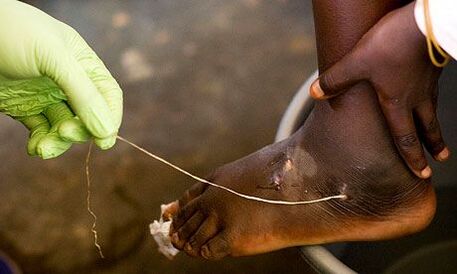 Usually, helminths are localized in a person's lower extremities.
Usually, helminths are localized in a person's lower extremities.
The main symptoms of injury include:
- rash on the legs;
- the formation of fluid-filled blisters;
- unbearable itching;
- the appearance of bumps;
- pus formation.
The main method of treatment is surgical removal of the worms from the body.
schistosomiasis
This disease causes several types of helminths found in bodies of water. Infection occurs when swimming in rivers and lakes of Africa and Asia. Another way of infection is untested drinking water. It is the source of the spread of eggs and larvae of the parasite. Initially, the helminths reside under the epidermis. Allergic rashes form on the skin, accompanied by itching. As the disease develops, the larvae penetrate deep into the body. The patient's kidneys and liver were severely affected. The disease is accompanied by fevers at night, profuse sweating. An enlarged liver and deformed kidneys can help diagnose an infection.
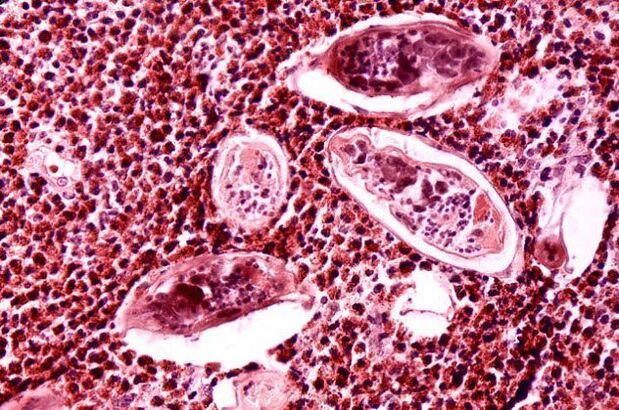
Cysticercosis
Tapeworm disease is a disease associated with human infection with tapeworms. Parasitic plant of the tenacious type, living in Asian countries. For the development of an adult in the human body, the penetration of 1 larva or part of a worm is enough. The parasite has a high regenerative capacity, which complicates the treatment process.
The main signs of lesions include urticaria, pruritus, general weakness, pain. Usually, the worms will reside under the skin, in the muscles, eyes, internal organs and brain. During adult development, a hard nodule or callus forms under the skin. Over time, it can add up, bringing inconvenience. The main breeding sites for tapeworms are the shoulders, chest, arms, and palms.
Dirofilaria
The main mode of infection of worms is the entry of larvae through insect bites or contact with animals. Temporary carriers are dogs and cats, mosquitoes act as carriers. The female worm is 30 cm long, the male is 10 cm long.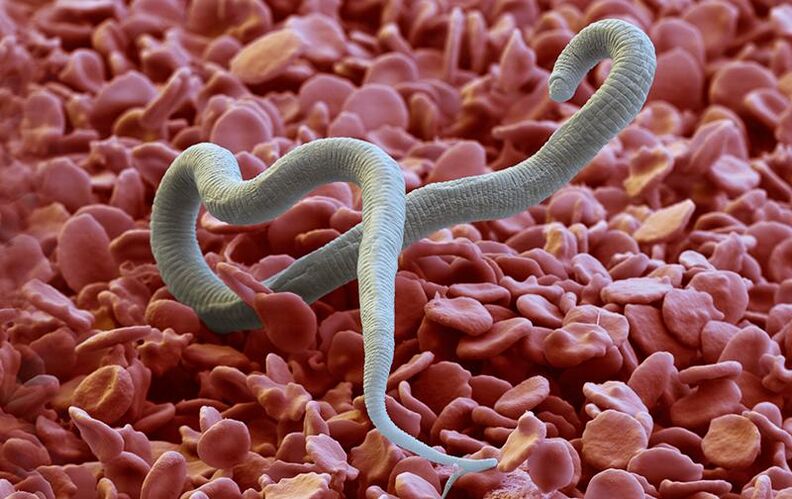 Parasite growth occurs under the upper layer of the epidermis.
Parasite growth occurs under the upper layer of the epidermis.
Eggs remain on human skin when bitten by a mosquito. The hatched larvae penetrate deep into the skin through the injured skin. There she goes through all the stages of adulthood. The disease is accompanied by unpleasant itching. Seals are recorded in areas of localization of worms. The patient feels the adult's movement under the skin. It is possible to lose vision if affected by helminths.
Treatment of worms is carried out by surgical method. After surgery, the patient is prescribed drugs that restore the skin and affected organs.
Scabies
Scabies is an infection of a person with scabies mites. The disease is named for the intense, unbearable itching all over the body. In places where fleas are located, people develop red rashes.
Infection by ticks occurs through physical contact with an infected person or his or her personal belongings. Diagnosis is made by visual examination of the skin and laboratory tests.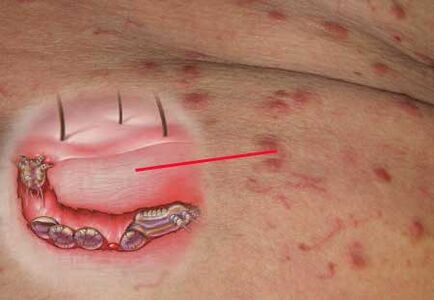 At home, the diagnosis can be made with iodine. When it comes into contact with infected skin, a spider web becomes noticeable - the passage of the tick under the skin of an infected person.
At home, the diagnosis can be made with iodine. When it comes into contact with infected skin, a spider web becomes noticeable - the passage of the tick under the skin of an infected person.
The main symptoms of scabies include:
- itching and redness of the skin;
- the formation of fluid-filled blisters when scratching the skin;
- localization of lesions on the hands and joints.
The treatment is lengthy and laborious. It is almost impossible to completely remove the parasite.
Demodecosis
Demodectic mange is a human infection with subcutaneous mites. They are localized in the sebaceous glands of the infected person. In its early stages, the disease can be easily confused with acne. As the ticks multiply, the rash enlarges and spreads all over the face. Eyelash loss begins.
The diagnosis of demodicosis is very simple. For this, a visual inspection is performed and several laboratory tests are performed. Treatment of the disease is long-term. In some cases, it takes several years. Tick transmission occurs through direct contact with an infected person, sharing personal items or cosmetic products of an infected person. The successful reproduction of ticks is facilitated by an unstable hormonal background, a weakened immune system.
Symptoms of the disease
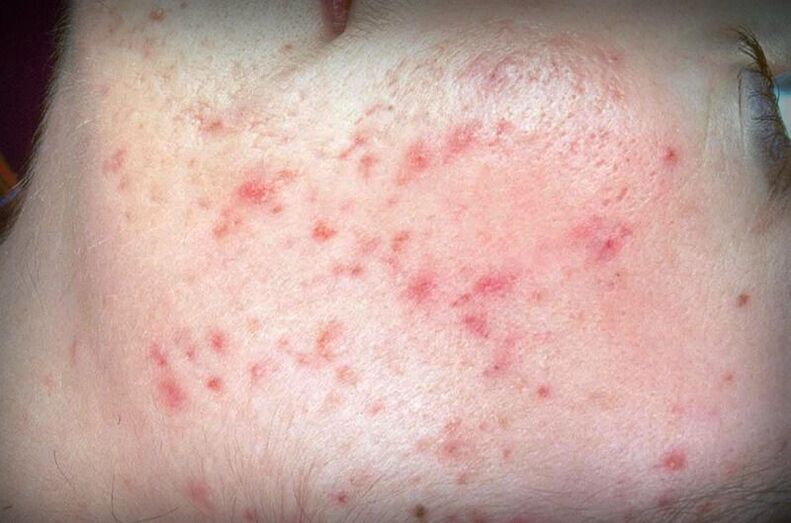
Modern medicine distinguishes several types of subcutaneous parasites. They provoke the development of dermatitis and disruption of internal organs. Depending on the human pathogen, the symptoms appear in a particular way. Even so, there are some signs that, when they appear, should be consulted by a specialist.
You can learn about worms in the body through some of the following signs:
- general weakness;
- temperature rises to 39 ° C;
- itchy skin of varying degrees;
- the appearance of a skin rash;
- gastrointestinal discomfort;
- the formation of seals on the skin.
It is important to note that an early visit to the doctor helps you to quickly clear the parasites that live under the human skin from the body.
Diagnostic Features
Subcutaneous parasites in humans are difficult to diagnose. For this reason, when the first injury is suspected, it is necessary to consult a specialist. The complexity of the diagnosis is directly related to the underlying course of the disease. Basically, vivid symptoms appear only a few years after the loss, negatively affecting health.

Some symptoms suggest a helminthic invasion, but there is no general clinical picture of the presentation. It is necessary to exclude the defeat of the patient with helminths in the case of reddened areas of the skin, the appearance of constant itching, various spots on the skin.
Visiting with several specialists allows you to make an accurate diagnosis:
- dermatologist;
- neurosurgeon;
- allergy;
- infectious disease specialist;
- psychologist.
A psychologist consultation will take place if no deviations are found in the direction of other specialists.
To clarify the diagnosis, the patient is assigned to examine:
- blood test for antigens;
- test a skin sample;
- blur;
- secret research;
- scrape from the affected area.
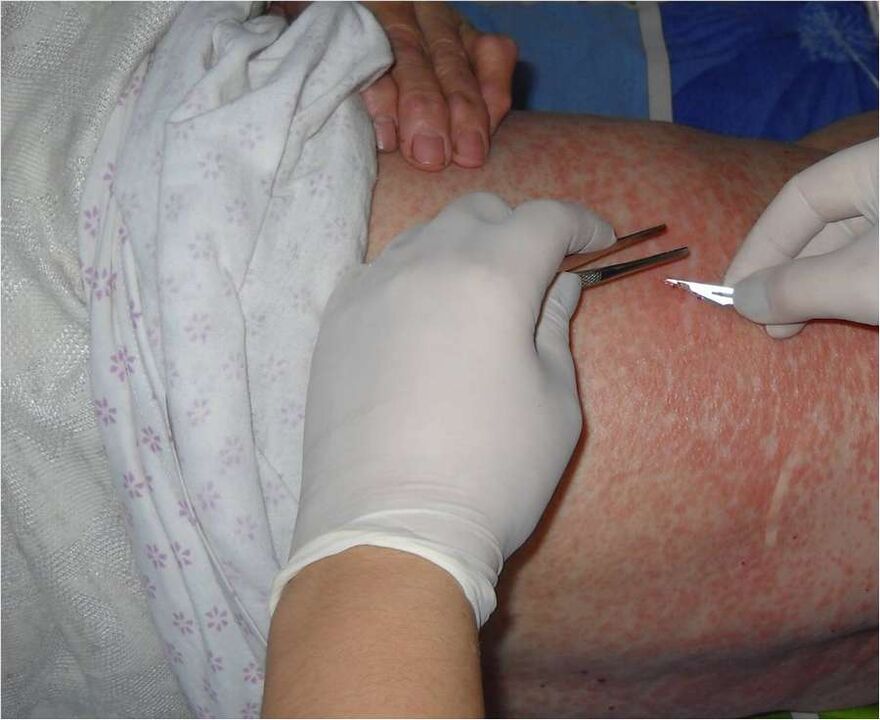
Lab test results can detect parasites under the skin. If within six months before the onset of symptoms have traveled to Asian countries or other tropical areas, this must be indicated to the doctor.
Diagnosis of subcutaneous parasites requires the appointment of a competent treatment regimen. In this situation, the use of drugs or traditional medicine methods not recommended by the attending physician is prohibited. Violation of the therapeutic regimen can lead to deterioration and intoxication of the body.
Effective treatments
In medical practice, there are two methods of treating parasites: medication and surgery. Depending on the complexity of the lesion, the doctor uses one method or a combination of both. The choice of treatment depends on the patient's health risk and the characteristics of the parasite.

The choice of therapy is influenced by:
- the number of parasites in the patient's body;
- the regenerative capacity of the worm;
- fertility rate;
- localization of the parasite;
- allergic reactions of the patient;
- the severity of the disease;
- possible or existing complications.
Drug therapy involves taking a course of medication. The effect of the drug is related to exposure in several directions:
- Kills adult worms and larvae in the body, preventing their reproduction. For this, dewormers are used.
- Eliminate inflammation and destroy the source of infection. For this, a course of antibiotic treatment is carried out.
- Accelerates the removal of toxins and eliminates allergic reactions. The patient was prescribed a course of antihistamines and glucocorticoids.
- Heal the affected skin areas. To accelerate the regenerative function of the epidermis, creams and ointments are used.
Surgical treatment of subcutaneous parasites is recommended in cases of severe complications and the specific location of the worm. The operation has been shown to be highly effective in cases where it is known that the body is affected only by one individual. Usually, surgical intervention is used for kidney stones. The worm's internal fluid contains a toxic substance that can cause anaphylaxis. In this case, a comprehensive extract of the parasite is shown.
Methods of prevention
Skin parasitic infections in humans require prolonged treatment. The problem can be avoided by following a few precautions:
- Observe the rules of hygiene. Hands should be washed under running water with soap or sanitizer. Especially after coming into contact with a strange or stray animal. Scratches, cuts, and other skin lesions should be treated with an antiseptic.
- Product processing. Fresh fruits and vegetables should be washed thoroughly under running water before use. Fish, poultry, and meat should be reheated. Avoid eating raw or semi-raw meat.
- Use proven water sources. Water from unknown sources must be treated. Open water bodies and springs need special attention.
- Periodic vaccination. Before traveling to tropical countries, it is necessary to vaccinate against major diseases.
- General use of makeup. Women should avoid sharing makeup, even with close friends.
- Swim in open water. Swimming in contaminated or untested waters is prohibited. During the hot season, priority should be given to water areas that have been tested for water quality.
A responsible attitude to one's own health and adherence to preventive measures help prevent skin diseases caused by parasites.























